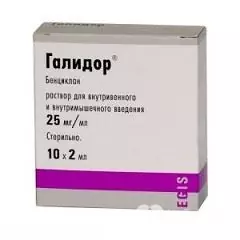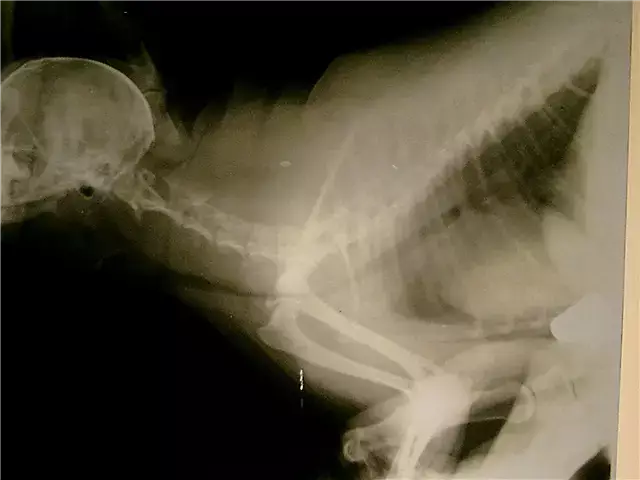- Author Rachel Wainwright [email protected].
- Public 2023-12-15 07:39.
- Last modified 2025-11-02 20:14.
Galidor
Instructions for use:
- 1. Release form and composition
- 2. Indications for use
- 3. Contraindications
- 4. Method of application and dosage
- 5. Side effects
- 6. Special instructions
- 7. Drug interactions
- 8. Analogs
- 9. Terms and conditions of storage
- 10. Terms of dispensing from pharmacies
Prices in online pharmacies:
from 292 rub.
Buy

Halidor is a myotropic spasmolytic drug with a pronounced vasodilating effect.
Release form and composition
Dosage forms of Halidor:
- Tablets: round, white or grayish-white in color, with a slight characteristic odor, bevelling and HALIDOR engraving on one of the flat sides (50 pcs. In dark glass bottles, 1 bottle in a cardboard box);
- Solution for intramuscular (i / m) and intravenous (i / v) administration: clear, colorless, odorless liquid (in 2 ml ampoules, in a blister strip of 5 ampoules; in a cardboard box, 2 packs each or in a cardboard box, 10 packs each)).
The active substance is bencyclane fumarate:
- 1 tablet - 100 mg;
- 1 ampoule - 50 mg.
Excipients:
- Tablets: polyvinyl acetate, potato starch, magnesium stearate, anhydrous colloidal silicon dioxide, carbomer 934 P, talc, sodium carboxymethyl starch (type A);
- Solution: sodium chloride for parenteral dosage forms, water for injection.
Indications for use
The use of Galidor is indicated for the treatment of vascular diseases:
- Peripheral vessels: pathologies with acrocyanosis and vasospasm, Raynaud's disease and chronic obliterating arterial diseases;
- Cerebral vessels: chronic and acute cerebral ischemia (as part of complex treatment).
The drug is prescribed to eliminate spasm of internal organs:
- Gastrointestinal pathologies: as part of the combined therapy of gastric ulcer and duodenal ulcer, colitis - infectious and inflammatory, gastroenteritis of various etiologies, especially infectious. Cholecystitis, condition after cholecystectomy, cholelithiasis, motility disorders with dyskinesia of the sphincter of Oddi. Functional pathologies of the large intestine, postoperative flatulence, tenesmus;
- Urological syndromes: concomitant therapy of urolithiasis (with renal colic - in combination with analgesics), tenesmus and bladder spasms.
In urology, Halidor is also used to prepare for instrumental research methods.
Contraindications
Contraindications to the use of Galidor are:
- Severe hepatic and renal impairment;
- Severe respiratory distress;
- Epilepsy and other forms of spasmophilia;
- Recent hemorrhagic stroke;
- Traumatic brain injury (within the last year);
- Decompensated heart failure;
- Atrioventricular block;
- Acute myocardial infarction;
- Age under 18;
- The period of pregnancy and breastfeeding;
- Hypersensitivity to drug components.
Method of administration and dosage
Halidor tablets should be taken orally. In the form of a solution - in the form of intravenous injections or infusions and deep intramuscular injections.
The doctor prescribes the course of treatment and the dosage form of the drug individually, taking into account the clinical indications and the patient's condition.
Recommended dosage for the treatment of vascular diseases:
- Tablets - 100 mg 3 times a day for 2-3 months. The daily dose should not exceed 400 mg. Break between courses - 2-3 months;
- Solution - 100 mg 2 times a day. 100 mg (4 ml) of the drug must be diluted in 100-200 ml of 0.9% aqueous sodium chloride solution and injected intravenously for 1 hour.
Dosing to relieve spasm of internal organs:
- Tablets - 100-200 mg once, the maximum daily dose is 400 mg. Maintenance therapy - 100 mg 3 times a day for 3-4 weeks, then 2 times a day. The drug is taken until the symptoms of the disease disappear, usually 1-2 months;
- Solution - in acute cases: 100-200 mg (4-8 ml) by intravenous slow injection or 50 mg (2 ml) - deep intramuscularly. For intravenous administration, the drug is diluted in 10-20 ml of 0.9% aqueous sodium chloride solution. The course of treatment is 2-3 weeks, then, if necessary, the patient is transferred to taking pills.
Side effects
The use of Halidor can cause the following side effects:
- From the side of the central nervous system (CNS): dizziness, headache, anxiety, gait and / or sleep disturbances, tremors, memory disturbances, insomnia. Rarely - transient confusion, hallucinations, epileptiform seizures. Very rarely - symptoms of focal lesions of the central nervous system;
- From the digestive system: a feeling of satiety, dry mouth, nausea, abdominal pain, vomiting, increased activity of hepatic transaminases in the blood serum;
- From the side of the cardiovascular system: sometimes - atrial and ventricular tachyarrhythmia (especially with the simultaneous administration of other proarrhythmogenic drugs);
- Others: weight gain, general malaise, leukopenia, allergic reactions. Rarely - thrombophlebitis may occur with intravenous administration.
special instructions
The daily dose of Halidor should not exceed 150-200 mg when treated in combination with cardiac glycosides, as well as with drugs that inhibit myocardial function or cause hypokalemia.
Parenteral administration of the drug is contraindicated in patients with severe cardiovascular or respiratory failure, with a predisposition to collapse; hypertrophy of the prostate; retention of urine.
In the case of prolonged use of the drug, it is recommended to conduct laboratory studies of the rheological properties of blood at least once every 2 months.
In case of parenteral administration, the injection sites should be changed periodically. the drug can cause damage to the vascular endothelium and thrombophlebitis.
At the beginning of the use of Galidor, special care must be taken when driving vehicles and performing potentially hazardous activities.
Drug interactions
When combined with sympathomimetics, the likelihood of developing atrial and ventricular tachyarrhythmias, tachycardia increases.
When used simultaneously with anesthetics and sedatives, Halidor enhances their inhibitory effect on the central nervous system.
When taken simultaneously with digitalis preparations, the risk of arrhythmia from a possible overdose of cardiac glycosides increases.
Caution should be exercised when combined with quinidine and drugs that lower the level of potassium in the blood (including cardiac glycosides and diuretics), since the summation of proarrhythmogenic effects is possible.
In the case of simultaneous administration of beta-blockers with Halidor, it is necessary to take into account the opposite of chronotropic effects - positive for bencyclane and negative for beta-blockers.
The drug may enhance the effect of calcium channel blockers and other antihypertensive drugs.
Simultaneous use with drugs that cause side effects in the form of spasmophilia can double these effects.
Consideration should be given to the possibility of enhancing the inhibition of platelet aggregation when combined with acetylsalicylic acid.
Analogs
Galidor's analogs are: Bencyclan, Bencyclan Fumarate, Dibazol, Dibazol-Darnitsa, Duzofarm, Vinoksin MV, Papazol, Enelbin 100 Retard.
Terms and conditions of storage
The drug should be stored out of the reach of children at a temperature of 15-25 ° C.
Shelf life:
- Tablets - 5 years;
- The solution is 3 years.
Terms of dispensing from pharmacies
Dispensed by prescription.
Galidor: prices in online pharmacies
|
Drug name Price Pharmacy |
|
Halidor 25 mg / ml solution for intravenous and intramuscular administration 2 ml 10 pcs. 292 r Buy |
|
Galidor 100 mg tablets 50 pcs. RUB 300 Buy |
|
Galidor tablets 100mg 50 pcs. RUB 525 Buy |
|
Halidor solution for intravenous and intramuscular injection. 25mg / ml 2ml 10 pcs. 544 r Buy |
|
Halidor 25 mg / ml solution for intravenous and intramuscular administration 2 ml 50 pcs. 663 r Buy |
Information about the drug is generalized, provided for informational purposes only and does not replace the official instructions. Self-medication is hazardous to health!






